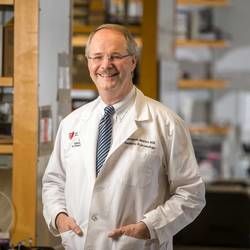Calls Now Open
2024 ADDF-Harrington + 2025 Harrington Scholar-Innovator Programs

Respiratory
A Respiratory Stimulant in Perioperative and Critical Care Settings
2016 Harrington Scholar-Innovator
The rapid gasping and grunting of a young child having breathing difficulties are distressing to witness and hard to forget.
Harrington Scholar Benjamin Gaston, MD, is Director of the Pulmonary Research Institute at Case Western Reserve University School of Medicine and Chief of the Pulmonary Division at University Hospitals Rainbow Babies & Children's Hospital.
In his early years as a pediatrician in the 1980s, Dr. Gaston encountered dozens of children in respiratory distress. Those memories have stayed with him. “The most difficult patients I saw in those days were those who had respiratory disease,” he recalls. “At the time, our options were really limited. It was hard to make them better and to keep them healthy.”
This critical need drove him to undertake a research fellowship to study pediatric breathing problems at Boston Children's Hospital. “I wanted to help solve those problems. I'm thankful to be involved in research that has created more options for these children,” Dr. Gaston explains. That experience helped set the course for his career in pediatric pulmonology. As a physician-scientist, he has translated basic science into a potential treatment for cystic fibrosis and developed potential treatments for children with the most severe forms of asthma.
Now, with support from Harrington Discovery Institute, Dr. Gaston is developing a first-in-class drug to stimulate the drive to breathe. This type of therapy is critically needed in treating infants and children and also in older patients, in settings ranging from the ICU to the battlefield. Dr. Gaston is hopeful that this drug will decrease the risk of respiratory side effects from the use of pain medication in children. “We want to help resolve a chronic disconnect faced in all children's hospitals: We hope the drug will enable children to breathe normally while, at the same time, having adequate sedation and pain control,” he explains.
“I try to think through innovative options to help each child. I always try to stay optimistic about what we can do to improve a child's outcome.”
Source: Article from 2015-16 Annual Publication.